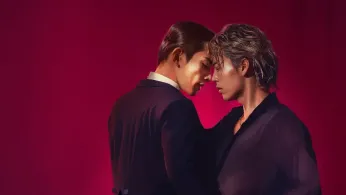
Nov 13
When Rivals Tango: Netflix’s “10DANCE” Spins Queer Romance Onto the Global Stage
READ TIME: 4 MIN.
The world of ballroom dance isn’t new to drama, but Netflix’s upcoming “10DANCE” is about to turn up the heat—and make it unmistakably queer. Launching globally December 18, the film adapts the cult-favorite manga into a cinematic showcase of sweat, sequins, and the kind of slow-building tension that has made “enemies to lovers” a favorite trope among LGBTQ+ viewers. But “10DANCE” isn’t just another dance movie; it’s a love letter to queer visibility, Asian storytelling, and the electric vulnerability that happens when you dare to let someone lead you across the floor .
Adapted from Satoh Inoue’s original manga, “10DANCE” follows Shinya Suzuki (Ryoma Takeuchi), reigning champion of Japan’s Latin dance scene, and Shinya Sugiki (Keita Machida), the nation’s king of standard ballroom and ranked second in the world. The two share a first name and a mutual obsession with excellence—but not much else. When Sugiki proposes they join forces to conquer the ultra-prestigious 10-Dance Competition, Suzuki’s initial response is a hard no. But in true rivals-to-lovers fashion, the friction between them soon becomes impossible to ignore .
What sets “10DANCE” apart? It’s not just the technical wizardry or the lush visuals (though those are promised in spades). It’s the unapologetic queerness at the center of the film—two men learning each other’s bodies, challenging the gendered traditions of ballroom, and discovering that real connection can’t be choreographed. Director Keishi Otomo, known for blending emotional depth with visual spectacle, told Netflix, “This film challenges us to explore the depths of love and its capacity,” hinting at the emotional resonance the story aims to bring .
The casting is a coup for fans of Japanese cinema and BL (Boys’ Love) narratives. Ryoma Takeuchi, making his Netflix film debut, and Keita Machida, already a familiar face to fans of “Alice in Borderland,” underwent months of intense ballroom training to inhabit their roles. Their on-screen partnership is being billed as electric, with both actors stepping outside their comfort zones: “It’s my first time dancing in a film, and the physicality really mirrors the emotional journey between Suzuki and Sugiki,” Takeuchi shared in a Netflix Q&A .
Supporting them is a strong ensemble and a creative team that includes screenwriter Tomoko Yoshida and a diverse cast of dance professionals and newcomers, all working under Otomo’s careful direction . The film’s production values—costume, choreography, and cinematography—promise to immerse viewers in the competitive, high-stakes world of ballroom, while never losing sight of the intimate emotional stakes.
Ballroom dance, with its rigid rules and gendered roles, has long been both a site of exclusion and secret rebellion for LGBTQ+ people. “10DANCE” throws open the doors, making queer love the main event, not just a whispered subplot. The competition itself requires mastery of both Latin and standard ballroom styles, forcing Suzuki and Sugiki to literally step into each other’s shoes. Their daily lessons, filled with sharp banter and even sharper glances, become a metaphor for queer intimacy—the push, the pull, the trust it takes to let someone in .
For many in the LGBTQ+ community, ballroom isn’t just a setting—it’s a symbol. From underground balls in 1980s New York to the international stages of today, dance has provided a space for queer self-expression, resistance, and chosen family. “10DANCE” draws on this lineage, but gives it a distinctly East Asian, global spin. The film’s Japanese-language dialogue and culturally specific storytelling signal a new era for international LGBTQ+ cinema, one where diverse voices and experiences take center stage .
At its heart, “10DANCE” is a romance—messy, tentative, and charged with longing. The chemistry between Suzuki and Sugiki is the film’s engine, driving both the narrative and the dance sequences. As they push each other to new heights, their rivalry gives way to something softer, more vulnerable. “They butt heads while they teach each other,” Netflix teases, “but as they grow closer, Suzuki realizes he has feelings for his dance partner” .
The film doesn’t shy away from the eroticism and tenderness of two men learning to move together. There’s a delicious tension in every close-up and a playful subversion of expectations—who leads, who follows, and what happens when those roles blur. In a media landscape where queer stories are often coded or sidelined, “10DANCE” places them front and center, inviting audiences to root for a love story that feels both universal and deeply specific.
For LGBTQ+ audiences, especially those hungry for more international and intersectional stories, “10DANCE” is more than just a movie. It’s a statement: that queer love can be epic, cinematic, and joyfully visible. Its arrival on Netflix means access for viewers across the globe, and its fusion of romance, rivalry, and dance promises to win new fans well beyond the usual BL crowd .
As director Otomo put it, “Dancing partners transcend boundaries and discover hidden emotions”—a sentiment that feels especially resonant in a time when LGBTQ+ rights, visibility, and joy remain both urgent and contested .
With “10DANCE,” Netflix isn’t just delivering a steamy, stylish romance—it’s inviting queer viewers to see themselves as the heroes of their own love stories, worthy of spotlight, applause, and a place on the winner’s podium. Whether you’re a die-hard BL fan, a ballroom devotee, or just in the mood for a film where the sparks (and rhinestones) fly, this is one dance you won’t want to miss.






